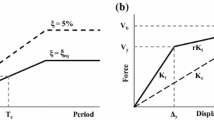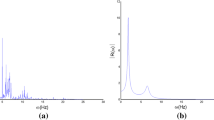Abstract
An improved version of the direct displacement-based design (DDBD) method for the seismic design of plane moment resisting frames in the framework of performance-based design approach is presented. The method employs a multi-degree-of-freedom equivalent system instead of the single-degree-of-freedom equivalent system used by the conventional DDBD method. Thus, the proposed method can take more rationally and with higher accuracy into account the higher mode and P-Δ effects than the conventional one. This is accomplished with the aid of the concept of deformation dependent equivalent modal damping ratios previously developed by the present authors for other purposes and the concept of the design modal displacements developed herein. These design modal displacements are determined on the basis of target inter-storey drift ratios for every performance level and the first few modes significantly contributing to the structural response. Thus, one can determine from the displacement spectrum with high amounts of viscous damping the required modal periods for known values of the design modal displacements. From those modal periods, the corresponding required modal stiffness and hence the modal base shear forces can be obtained. The final required design base shear can be obtained by a combination rule, like the SRSS rule. Numerical examples involving the seismic design of two moment resisting reinforced concrete plane frames are presented in detail for illustrating the proposed approach and demonstrating its merits over the conventional DDBD method and the force-based design method of Eurocode 8.














Similar content being viewed by others
Change history
08 June 2020
This erratum is published as proofing errors were introduced in fig.1 during typesetting and needs to be correctly read as.
References
ATC72-1 (2010) Modeling and acceptance criteria for seismic design and analysis of tall buildings. Applied Technology Council, Redwood City
Bozorgnia Y, Bertero VV (eds) (2004) Earthquake engineering: from engineering seismology to performance-based engineering. CRC Press, Boca Raton
Calvi GM, Sullivan TJ (2008) Development of a model code for direct displacement-based seismic design. IUSS Press, Pavia
Carr AJ (2006) Ruaumoko manual, theory and user guide to associated programs. Department of Civil Engineering, University of Canterbury, Christchurch
Chopra AK (2011) Dynamics of structures, 4th edn. Pearson, Upper Saddle River
Chopra AK, Goel RK (2001) Direct displacement-based design: use of inelastic vs. elastic design spectra. Earthq Spectra 17(1):47–64
EC8 (2004) Eurocode 8-design provisions for earthquake resistant structures. EN-1998-1: 2004, European Committee of Standardization, Brussels
Eurocode 2 (EC2) (2004) Design of concrete structures, part 1.1: general rules for buildings. European Standard EN 1992-1-1, European Committee for Standardization (CEN), Brussels
FEMA-356 (2000) Prestandard and commentary for the seismic rehabilitation of buildings. Federal Emergency Management Agency, Washington DC
Günay S, Mosalam KM (2013) PEER performance-based earthquake engineering methodology, revisited. J Earthq Eng 17(6):829–858
Jacobsen LS (1930) Steady forced vibrations as influenced by damping. Trans ASME 52(1):169–181
Moehle JP (1992) Displacement-based design of RC structures subjected to earthquakes. Earthq Spectra 8(3):403–428
Muho EV (2017) Seismic design of planar concrete frames using modal strength reduction factors. Ph.D. Thesis, Department of Civil Engineering, University of Patras, Patras, Greece (in Greek)
Muho EV, Papagiannopoulos GA, Beskos DE (2019) A seismic design method for reinforced concrete moment resisting frames using modal strength reduction factors. Bull Earthq Eng 17:337–390
Muho EV, Papagiannopoulos GA, Beskos DE (2020) Deformation dependent equivalent modal damping ratios for the performance-based seismic design of plane R/C structures. Soil Dyn Earthq Eng 129:105345
O’Reilly GJ, Calvi GM (2019) Conceptual seismic design in performance-based earthquake engineering”. Earthq Eng Struct Dyn 48(4):389–411
O’Reilly GJ, Calvi GM (2020) Quantifying seismic risk in structures via simplified demand–intensity models. Bull Earthq Eng 18:2003–2022
O’Reilly GJ, Sullivan TJ (2016) Direct displacement-based seismic design of eccentrically braced steel frames. J Earthq Eng 20(2):243–278
Panagiotakos TB, Fardis MN (1999) Deformation-controlled earthquake-resistant design of RC buildings. J Earthq Eng 3(4):495–518
Panagiotakos TB, Fardis MN (2001) A displacement-based seismic design procedure for RC buildings and comparison with EC8. Earthq Eng Struct Dyn 30:1439–1462
Papagiannopoulos GA, Beskos DE (2010) Towards a seismic design method for plane steel frames using equivalent modal damping ratios. Soil Dyn Earthq Eng 30:1106–1118
PEER (2013) Pacific Earthquake Engineering Research Centre, Strong ground motion database
Pennucci D, Calvi GM, Sullivan TJ (2009) Displacement-based design of precast walls with additional dampers. J Earthq Eng 13(sup1):40–65
Priestley MJN (1993) Myths and fallacies in earthquake engineering-conflicts between design and reality. Bull N Z Natl Soc Earthq Eng 26(3):328–341
Priestley MJN (2000) Performance based seismic design. Bull N Z Soc Earthq Eng 33(3):325–346
Priestley MJN, Kowalsky MJ (2000) Direct displacement-based seismic design of concrete buildings. Bull N Z Soc Earthq Eng 33(4):421–443
Priestley MJN, Calvi GM, Kowalsky MJ (2007) Displacement-based seismic design of structures. IUSS Press, Pavia
Priestley MJN, Calvi GM, Kowalsky MJ, Powell GH (2008) Displacement-based seismic design of structures. Earthq Spectra 24(2):555
Roldán R, Sullivan TJ, Corte GD (2016) Displacement-based design of steel moment resisting frames with partially-restrained beam-to-column joints. Bull Earthq Eng 14:1017–1046
SAP (2016) 2000 structural analysis program, computers and structures, Inc., California, USA. https://www.csiamerica.com/products/sap2000
SEAOC, Vision 2000 (1995) A framework for performance-based seismic engineering. Structural Engineering Association of California, Sacramento, California
Shibata A, Sozen MA (1976) Substitute structure method for seismic design in reinforced concrete. J Struct Div ASCE 102(1):1–18
Sullivan TJ (2013) Highlighting differences between force-based and displacement-based design solutions for reinforced concrete frame structures. Struct Eng Int 2:122–131
Sullivan TJ, Calvi GM, Priestley MJN, Kowalsky MJ (2003) The limitations and performances of different displacement based design methods. J Earthq Eng 7(SI 1):201–241
Sullivan TJ, Priestley MJN, Calvi GM (2006) Direct displacement based design of frame-wall structures. J Earthq Eng 10(SI 1):91–124
Sullivan TJ, Priestley MJN, Calvi GM (2008) Estimating the higher-mode response of ductile structures. J Earthq Eng 12:456–472
Sullivan TJ, Priestley MJN, Calvi GM (eds) (2012) A model code for the displacement-based seismic design of structures. DBD12, IUSS Press, Pavia
Žižmond J, Dolšek M (2019) Formulation of risk-targeted seismic action for the force-based seismic design of structures. Earthq Eng Struct Dyn 48(12):1406–1428
Acknowledgements
Dr. E. V. Muho and Professor J. Qian are grateful to the National Key Research and Development Program of China (Grant No. 2017YFC1500701) and the State Key Laboratory of Disaster Reduction in Civil Engineering (Grant No. SLDRCE15-B-06) for supporting this work.
Author information
Authors and Affiliations
Corresponding author
Additional information
Publisher's Note
Springer Nature remains neutral with regard to jurisdictional claims in published maps and institutional affiliations.
Rights and permissions
About this article
Cite this article
Muho, E.V., Qian, J. & Beskos, D.E. A direct displacement-based seismic design method using a MDOF equivalent system: application to R/C framed structures. Bull Earthquake Eng 18, 4157–4188 (2020). https://doi.org/10.1007/s10518-020-00857-5
Received:
Accepted:
Published:
Issue Date:
DOI: https://doi.org/10.1007/s10518-020-00857-5




